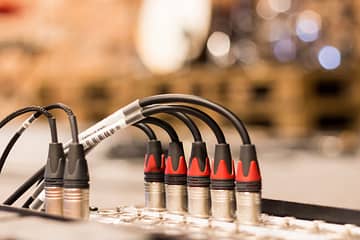Written By Lilly Weisman
Even for people experienced with technology, the audio/visual aspect of event planning can be overwhelming. Luckily, Tech 12 is here to provide you with a list of things to cross off of your checklist before your next event.

- Check Your Content
If you want to present a PowerPoint or video at your event, the first thing to check for before handing it over to the audio/visual company is that the file is in the correct aspect ratio. Typically, the A/V team provides screens that are on site – meaning, there are a few options in size, but these options are often limited. If the aspect ratio is set to the standard, which is 4:3, your impactful images will look stretched out and all around crappy. Changing your aspect ratio to 16:9 makes the presentation widescreen, so it will fill the entire screen at the event and dazzle your attendees. Click here for a step by step guide on how to do this.
- Make Sure Your Content Is Playable
So, you’ve created a PowerPoint that will convince your attendees to donate to your cause, or that shows Uncle Bob in all his glory for his 80th birthday. You’ve set the aspect ratio to 16:9 to ensure the slides that you’ve so carefully curated fill the screen. And now, all that’s left to do is send it to the A/V team and you’re done, right? Well, if you have an embedded video included in your presentation, the answer is no.
Embedded videos may work for smaller scale settings, such as a high school classroom, but embedding a video is not the most reliable option. With a professional technical team on site, the best way to present your videos is by putting them on a flashdrive or other data capturing device and handing it to the A/V technician working on the show. This way, your videos will be played flawlessly and right on time.
You should also check any videos, PDF’s or any other content you are sharing. Make sure that everything is the latest version and is playable. A good test prior to the show will help make sure everyone has the right content to share.
- Check Your Microphones
On the day of your event, the stars of the show will be the speakers – announcers, panelists, authors, you name it! But if your speaker isn’t mic’d up properly, none of the attendees will be able to hear a single word they say, and it also increases the risk of ear-deafening feedback. Follow the 3 P’s to guarantee that your speakers are heard loud and clear throughout the room.
- Placement – lavalier mics should rest on a lapel or collar, and the microphone itself should be facing upwards towards the speaker’s mouth. Before speaking, make sure that it is still placed properly.
- Power – when using a lav mic or a handheld mic, remember that you do not have to be in charge of turning the microphones on and off in between speaking. In fact, it often causes awkward silences if you don’t remember to turn it back on before speaking again. The A/V technicians are trained and will control the microphones from the tech table in the room, so once they’re on, leave ‘em on.
- Position – as a speaker, it’s important to be aware of where the microphone is, especially with handheld mics. The A/V team will run a soundcheck ahead of time, but this will not help much if you’re holding the mic a foot away from your face. A good rule of thumb is too hold the mic in a way that doesn’t block your face, about six inches away from your mouth. And if you sound too loud or too quiet, adjust the position accordingly!
- Leave Time To Test
The big day has arrived! All of the details are ironed out, no expense has been spared, and you’re feeling confident that this will be the event of the year! Your event is set to start at 4:00pm, and you roll in at… 3:50. Ten minutes is never enough time to test everything that your A/V team has provided for you.
Often, there are little components that may be overlooked in the face of larger details: do you need a light on the podium? An adapter so that your computer can be hooked up to the projector? Does one of your speakers have a super quiet voice? These are all things that take time to figure out, sometimes more than the ten or twenty minutes you’ve spared before the event kicks off. It’s important to arrive at least an hour before the event so that any hiccups or additions can be taken care of before your guests have time to say, “Cocktail hour!”

Following these four steps will help your event run smoothly, but Tech 12 guarantees that it truly will be the event of the year. Book Tech 12 for your all of your audio/visual and technology needs!


0 Comments